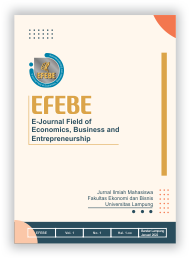Ketimpangan Ekonomi Wilayah di Indonesia : Perspektif Analitis Pengaruh Ekonomi, Infrastruktur, dan Demokrasi
DOI:
https://doi.org/10.23960/efebe.v3i2.251Keywords:
Regional Economic Inequality, Investment, Economic Growth, Road Infrastructure, DemocracyAbstract
Regional economic inequality in Indonesia is still a major challenge in national development. This study is purposed to analyze the effect of investment, economic growth, road infrastructure, and democracy on regional economic inequality in Indonesia during the period 2018-2023. The data used is secondary data from the Central Bureau of Statistics (BPS) which is processed using panel data regression with FEM approach. The output showed that the variables of investment, economic growth, road infrastructure, and democracy partially had a significant effect on regional economic inequality. Simultaneously, the variables of investment, economic growth, road infrastructure, and democracy have a significant effect on regional economic inequality in Indonesia. The of 0.989608 indicates that 98.96 percent of the variation in regional economic inequality can be explained by the independent variables in the model, while the 1.04 percent is influenced by other factors. Based on these results, strategic efforts are needed in the form of equitable investment between regions, strengthening fiscal decentralization, accelerating road infrastructure development in underdeveloped regions, and improving the governance and quality of regional public services.
Downloads
Published
How to Cite
Issue
Section
License
Copyright (c) 2025 Devita Sari, Arivina Ratih Yulihar Taher, Prayudha Ananta, I Wayan Suparta

This work is licensed under a Creative Commons Attribution-ShareAlike 4.0 International License.
E-journal Field of Economics, Business and Entrepreneurship is licensed under a Creative Commons Attribution-ShareAlike 4.0 International License Copyright Notice.









